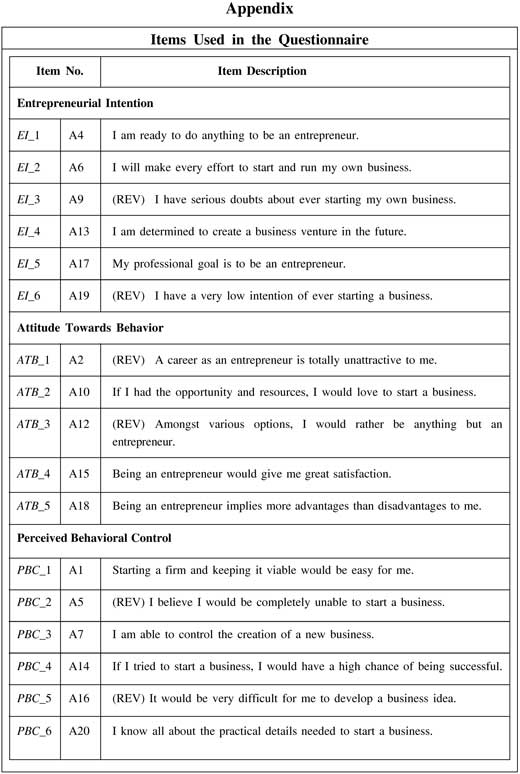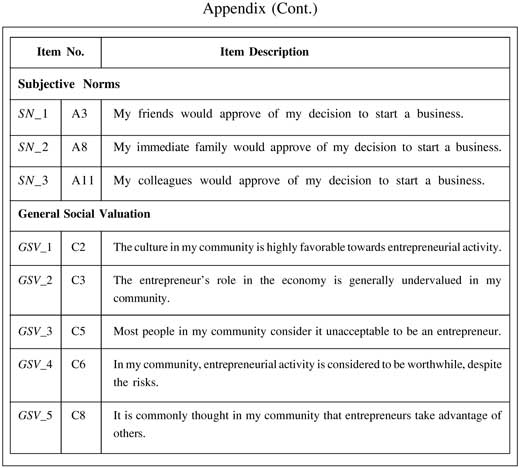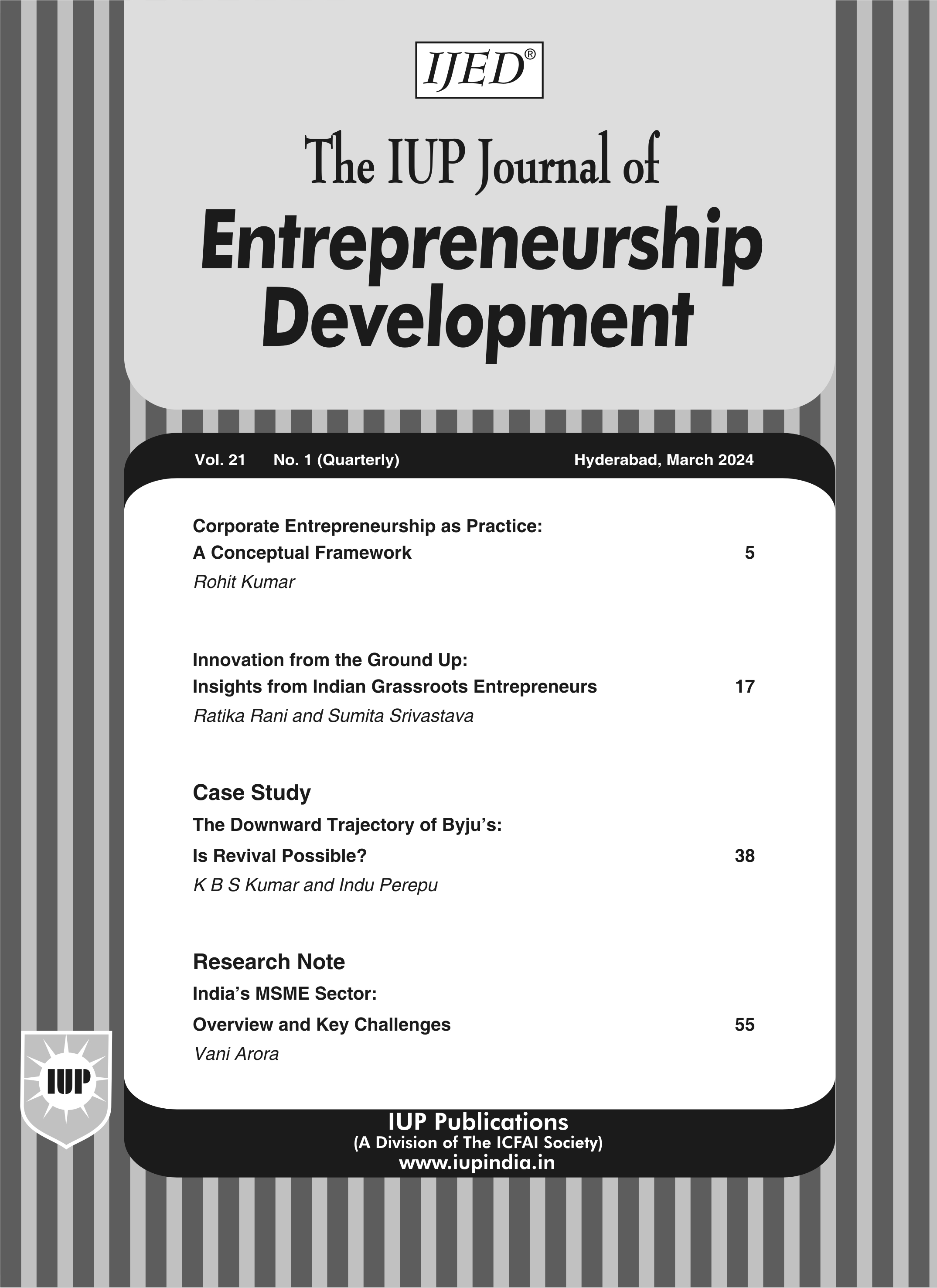
Sep'18
The IUP Journal of Entrepreneurship Development
Archives
Application of PLS-SEM in Modeling the Significance of Social Valuation in the Determination of Entrepreneurial Intention of Business Management Students
Indira Singh
Assistant Professor,
Sheila Raheja School of Business Management and Research,
Mumbai 400051, Maharashtra, India;
and is the corresponding author.
E-mail: indirasingh@srbs.edu.in
T Prasad
Professor of Student Start-Ups,
National Institute of Industrial Engineering (NITIE),
Mumbai 400087, Maharashtra, India.
E-mail: nitieprasad@gmail.com
Entrepreneurial intention is a precursor to actual entrepreneurial behavior. Entrepreneurship is recognized as a key determinant of economic growth and progress, yet there are conflicting findings in literature on the role of closer and wider social valuation in entrepreneurial intention formation. The study is an attempt to close this gap as it specifically delves into the role played by social valuation in configuring entrepreneurial intentions. The study is based on the Theory of Planned Behavior (TPB) and investigates the relationship between social valuation, TPB constructs and entrepreneurial intention. Data was collected from 480 final year business management students using convenience sampling method. The data was analyzed by deploying variance-based Partial Least Squares Structural Equation Modeling (PLS-SEM) to test the proposed model. The findings of the study validate the model as it has an explanatory power of 76.2%. The findings support the major role played by social valuation in configuring entrepreneurial intentions. All the model paths are found to be supported.
Introduction
Across the world, a plethora of activities are being initiated towards the support of entrepreneurial activity as entrepreneurship is considered as the backbone of a country's economy (Piperopoulos and Piperopoulos, 2010). It is needless to mention that the importance of entrepreneurship as a driver of growth and economic stabilization, job creation and subsequent reduction of the unemployment rate is recognized by policy makers. India being no exception has taken initiatives to encourage and foster entrepreneurship. India has introduced several initiatives to facilitate entrepreneurship and doing business in the country. The results are visible as in 2018 India jumped 30 spots to secure a place among the top-100 countries on World Bank's ease-of-doing business ranking list. Hence, India is now actively making conscious efforts through favorable policies to create entrepreneurial intentions among the population in order to drive the economy through the resultant multiplier effects of new ventures.
Entrepreneurial activity is viewed as a result of certain complicated cognitive processes. Literature corroborates that it is a matter of intentional planning. Before an individual engages in entrepreneurial activities, intention for the same is formed through cognitive processing of environmental factors. The various antecedents of entrepreneurial intention are described as entrepreneurial cognitions. As elaborated by Mitchell et al. (2002, p. 9), entrepreneurial cognitions are viewed as "the knowledge structures that people use to make assessments, judgments, or decisions involving opportunity evaluation, venture creation, and growth." In tune with this, entrepreneurial intentions in this study are defined as an individual's conscious awareness and conviction to start a new venture in the near future (Thompson, 2009).
The present study enhances the understanding of the Theory of Planned Behavior (TPB) and advances it further by the insights gained in the Indian context. India is a culturally diverse country, therefore the applicability of the TPB and the insights gained will be critical in advancing the theory further.
Unemployment is a chronic problem in the Indian subcontinent. The statistics conclude that "Unemployment in India is projected to witness marginal increase between 2017 and 2018, signaling stagnation in job creation in the country" (World Employment and Social Outlook – Trends, 2017). The report found economic growth lagging behind employment needs and indicates rising unemployment, as job creation was not expected to pick up pace in 2017 and 2018. Unemployment in India is projected to the extent of 17.8 million in 2018 or 3.4% in 2017-18 in the same report. These figures are a clarion call to educationists and policy makers to encourage entrepreneurship in the country so that it can be taken up as a viable career. This is a major challenge as low belief about entrepreneurship as a good career choice exists and high status is not accorded to entrepreneurs (less than 50% for both indicators) (GEM Report, 2017).
The above scenario indicates a massive need to study entrepreneurial intentions, especially of youth, so that they see an opportunity to create employment thereby contributing towards economic growth. Therefore, knowledge of various antecedents of entrepreneurial intention is vital, as such knowledge will help in the design of interventions to stimulate entrepreneurial activities.
The present study addresses the following research questions:
- Do the TPB constructs—personal attitude, perception of behavioral control and subjective norms—sufficiently explain the entrepreneurial intentions of business management students?
- To what extent does general social valuation contribute towards configuring entrepreneurial intentions of business management students?
Literature Review
The domain of entrepreneurship has emerged as a promising field of scholarly enquiry. Liñán and Fayolle (2015) presented dominant themes of enquiry in this domain such as those based on entrepreneurship intention model, personal level variables, entrepreneurship education, cultural and cross-cultural context, entrepreneurial process and emerging areas like sustainable entrepreneurship. This review delves into the antecedents of entrepreneurial intention.
In the entrepreneurship literature, many scholars have focused on intentions (Bird, 1988; and Krueger et al., 2000) as a precursor to actual behavior of choice. For assessing intention for entrepreneurial behavior, TPB (Ajzen, 1991) has been widely deployed in literature (e.g., Kolvereid, 1996; Krueger et al., 2000; Bansal and Taylor, 2002; Luthje and Franke, 2003; Souitaris et al., 2007; Van-Gelderen et al., 2008; and Heuer and Kolvereid, 2014). Intention formation is a cognitive process. It is postulated that intention is a precursor to actual behavior, i.e., intention leads to the desired behavior. The versatility of the TPB has been established as it has received considerable attention in diverse fields like social sciences (e.g., Davidsson and Honig, 2003; and Liñán and Santos, 2007), health sciences (Blue et al., 2008), entrepreneurship education (Farooq et al., 2016), purchase intention (Maichum et al., 2016), etc. The theory proposes a model that incorporates three antecedents—attitude towards behavior, subjective norms and perceived behavioral control. These three antecedents configure entrepreneurial intentions in an individual. Attitudes are an evaluation of perceived like or dislike of the behavior. The behavior is attractive to the individual if the evaluation is advantageous (Ajzen, 1991). Subjective norms refer to normative beliefs of the individual. These are configured based on the evaluation of the behavior by the significant others (reference people—family, friends, and colleagues). An individual would comply or avoid the behavior based on subjective norms. It indicates social pressure to perform or avoid the behavior of choice, in this case entrepreneurial behaviors (Ajzen, 1991). Perceived behavioral control refers to an individual's subjective assessment of the ease or difficulty level of entrepreneurial behavior and whether he will be able to control the behavior and therefore successful venture creation (Ajzen, 2002).
The Concept of Social Valuation
The concept of social valuation has its roots in social capital theory. This theory helps to explain the impact of environmental factors on entrepreneurial intentions. Social capital implies social relationships (Lin, 2003). It can be defined as the sum of current and potential resources incorporated in, available in and derived from the network of relations possessed by a person or social unit (Nahapiet and Ghoshal, 1998).
The process of entrepreneurship is embedded in society or rather it is a process involving social, cultural and economic contexts. A stream in literature propounds that entrepreneurship is enmeshed in social networks and therefore comprises several networks and interpersonal relationships (McKeever et al., 2014, p. 468). Social valuation refers to the shared values regarding entrepreneurship among a particular society or close group of people. Such valuation determines to a large extent how an individual from the same group or culture would perceive entrepreneurship as a career (Liñán et al., 2011, p. 192 and 2013, p. 81). Therefore the formation of intention for entrepreneurial behaviors can be impacted positively by positive valuation of such behaviors such as entrepreneurs being given media attention, media reporting favorably about successful businesses, and entrepreneurs given high accord can motivate individuals towards taking steps to undertake such activities. The social learning theory indicates that observed positive outcomes can motivate individuals to adopt similar rewarded activities (Bandura, 1986, p. 283).
A positive social valuation will not only boost and make the intention for entrepreneurial behavior firm, but it will also pave the way for the much-desired nascent entrepreneurial behaviors in potential entrepreneurs. Therefore it is assumed that there is a link between social valuation and positive view of entrepreneurial behaviors and therefore a strong intention. In this regard, this study is an effort to better understand how positive social valuation affects entrepreneurial intention.
Objective
Based on the research questions discussed earlier, the present study aims to:
- Determine the relationship between the attitudes towards becoming an entrepreneur, perceived behavioral control, subjective norms and entrepreneurial intention.
- Determine the relationship between social valuation of entrepreneurship and the attitude towards becoming an entrepreneur, perceived behavioral control, subjective norms and entrepreneurial intention.
- Examine the mediatory role of social valuation between attitude, subjective norms, perception of behavioral control and entrepreneurial intention.
Conceptual Framework and Formulation of Hypotheses
Conceptual and theoretical framework is understood as an aggregation of inter-related concepts pertinent to the study that is being carried out. The framework serves as a guide to the study determining what is to be measured, tested and what statistical relationships the study will seek to find out. It is also referred to as "a conceptual model on how one theorized or made logical sense of the relationships among the several factors under study" (Sekaran, 2003).
The conceptual model with indicator variables is depicted in Figure 1. The conceptual model has theoretical underpinnings in the work of Liñán et al. (2009). The model basically investigates the linkage of a particular contextual factor—the social valuation of entrepreneurial behaviors—in the wider network of the individual. Such networks create contextual factors in which an individual operates. Through the model, meditation will also be explored among the constructs in the model. Liñán et al. have proposed that social valuation influences intention for entrepreneurial activities through attitude towards behavior, subjective norms and perceived behavioral control. A survey of literature has supported this model (Lent et al., 1994). The study is an effort to establish the model with exclusive sample of business students from the Indian subcontinent.
Based on the review of related literature, the following hypotheses are framed:
H1: Attitude towards behavior (ATB) is positively related to entrepreneurial intention (EI).
H2: Social valuation of entrepreneurship (GSV) is positively related to attitude towards entrepreneurial behaviors (ATB).
H3: Social valuation of entrepreneurship (GSV) is positively related to intention for entrepreneurial behaviors (EI).
H4: Social valuation of entrepreneurship (GSV) is positively related to perception of behavioral control (PBC).
H5: Social valuation of entrepreneurship (GSV) is positively related to subjective norms (SN).
H6: Perception of control of entrepreneurial behaviors (PBC) is positively related to intention for entrepreneurial behaviors (EI).
H7: Favorable subjective norms (SN) towards entrepreneurial behaviors are positively related to intention for entrepreneurial behaviors (EI).
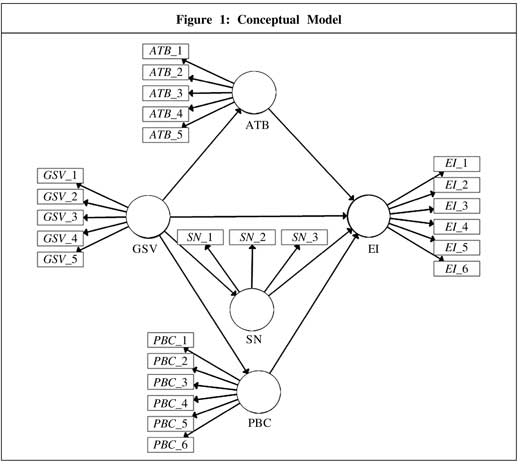
Data and Methodology
Unit of Analysis and Data Collection
The unit of analysis in the present study comprises the final year business management students. The sample size was determined as per the recommendation of Costello and Osborne (2005) where sample requirement of 10-15 per questionnaire item is mentioned. The Entrepreneurial Intention Questionnaire (EIQ) had 38 items, therefore the sample size 480 was adequate and met the recommendation.
Data was collected with the 38-item EIQ adopted from literature (Liñán and Chen, 2009). The items used in the questionnaire are presented in the Appendix. The data was collected over a period of six months from various management institutes in Mumbai, India. A total of 1,200 questionnaires were distributed, out of which 850 questionnaires were returned, 480 were complete and usable, and thus retained for analysis, while the rest were discarded. Thus, the response rate is 40%.
Sampling
Non-probability convenience sampling is used in this study. This technique enabled the researcher to obtain 480 completed questionnaires in a short span of time and in an economical way. Through this technique, the researcher managed to randomly select respondents as per the ease of the researcher (Sekaran and Bougie, 2010; and Zikmund et al., 2010).
Data Analysis
In the present study variance-based Partial Least Squares-based Structural Equation Modeling (PLS-SEM) was deployed for data analysis. The technique was developed by Ringle et al. (2005). It is a popular versatile variance-based multivariate data analysis method (Lowry and Gaskin, 2014) primarily used for theory building studies (Sarstedt, 2008; and Vinzi and Russolillo, 2010). The approach is considered appropriate for examining complex models with untested cause-effect relationships (Henseler et al., 2009; and Lowry and Gaskin, 2014). To test hypotheses and establish the cause-effect relationships, SmartPLS 3 software (Ringle et al., 2014) was used.
Data Screening
The data was made ready for analysis after thoroughly screening it for outliers, normality issues, missing values and demographic profile of respondents. PLS algorithm was computed and the items with factor loadings less than 0.30 were depurated. Thereafter the evaluation of measurement model process was initiated.
Evaluation of the Measurement (Proposed) Model
The model studied in the present paper is an extended TPB model. The model was proposed to explain the role of General Social Valuation (GSV), Attitude Towards Behavior (ATB), Subjective Norms (SN) and Perception of Behavioral Control (PBC) on Entrepreneurial Intentions (EI) of final year business management students. The indicators for all the dimensions are considered as reflective because they are mutually interchangeable (Ketchen, 2013).
The results of the evaluation of the reflective measurement model are displayed in Table 1. The criterion of cross-loadings was used to assess the discriminant validity of the indicators forming the construct. It can be observed that the indicators are loading adequately with the construct represented.
Table 2 presents the internal consistency, reliability, indicator validity and convergent and discriminant validity of the proposed measurement model. The thumb rule prescribed by Ketchen (2013) for evaluating reflective measurement models was followed to evaluate the model. Accordingly, the constructs exhibited internal consistency and reliability because the composite reliability is higher than 0.70.
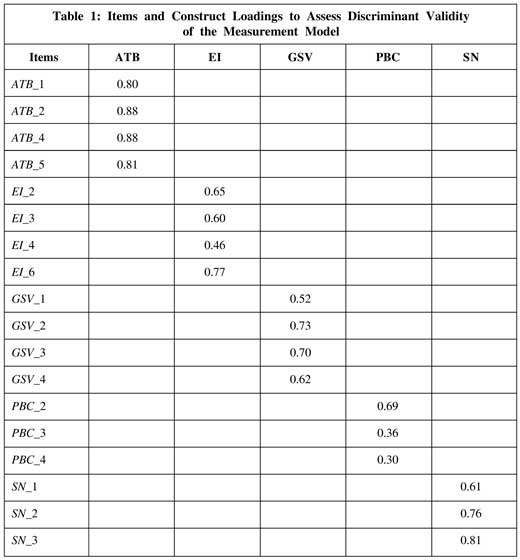
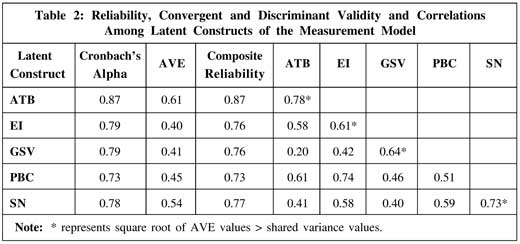
All the AVE values are greater than 0.40 (Kline, 2005; and Hair et al., 2010). Therefore it is inferred that the constructs are adequately distinct from other constructs, thereby establishing unidimensionality of the model. The PBC construct appears to have discriminant validity problems but is retained as such as other model fit criteria are adequate and standardized scales (Liñán and Chen, 2009) have been used to collect data. Therefore discriminant validity was established through the Heterotrait-Monotrait (HTMT) ratio criterion.
Discriminant Validity
The HTMT ratio (Henseler et al., 2015) was also deployed for assessing discriminant validity in PLS-SEM model. Literature reports that traditional approaches deployed to determine discriminant validity have low sensitivity (Henseler et al., 2015). Therefore, alternative criterion was derived from the classical Multitrait-Multimethod (MTMM) matrix (Campbell and Fiske, 1959). The new approach, i.e., HTMT ratio analysis, permitted a systematic discriminant validity assessment to establish construct validity in variance-based SEM models (Henseler et al., 2015). The results of HTMT ratio analysis indicated adequate discriminant validity for the study model (Table 3).
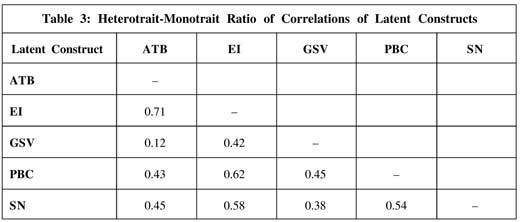
Results and Discussion
The present study was designed with the main purpose of analyzing the influence of general social valuation on the central constructs of the TPB and therefore entrepreneurial intention of business management students. The sample consisted of 480 final year students of business management, out of which 58% were males and 42% were females (Table 4).
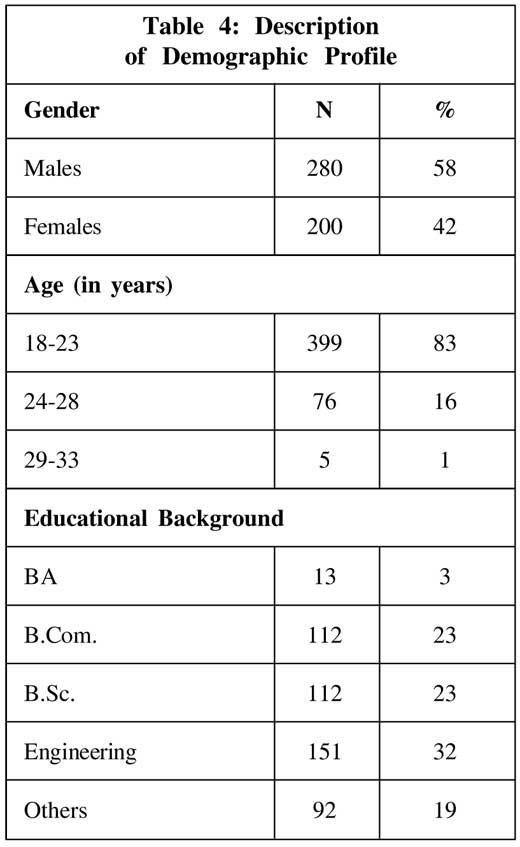
Both males and females are adequately represented in the sample. The students are all studying the curriculum prescribed by University of Mumbai that includes courses in entrepreneurship in-built in the curriculum. Moreover, all the institutes from where data was collected try to enhance the entrepreneurial intention of the students by various interventions like holding entrepreneurship awareness drive, organizing e-week, contests, e-talks and other competitions. The students are made aware of entrepreneurship as a viable career option. Also, Mumbai being the commercial capital of the country, there is esteem associated with being an entrepreneur. Also in the backdrop, Mumbai is home to many rich and successful entrepreneurs and successful traditional business communities.
Entrepreneurship courses are taught in MBA curriculum in both the first year and second year. The point to consider is: Are such courses helping in developing a favorable social valuation and therefore entrepreneurial intentions among the business students? The same is not evident on the ground as the number of students opting for entrepreneurship is miniscule as compared to students opting for salaried jobs. The study by Srivastava and Misra (2017) with exclusively females as sampling units found that Indian society did accept entrepreneurship as a viable career option and did recognize the worth of entrepreneurs in society. Social valuation emerged as one of the strongest factors affecting entrepreneurial intentions of young women in India. When the data was collected through interviews, the same study revealed that the participants had no intention to run a business and had never thought about it as a career option. The study brought about the dichotomy about entrepreneurial career that is present in the Indian society. While entrepreneurs are acknowledged and socially accepted, the society favors salaried jobs.
Evaluation of the Structural Model and Hypotheses Testing
The measurement model was confirmed based on reliability and validity of the constructs. Thereafter, evaluation of the structural model was done. This involved examining the predictive capability of the model and the relationships between the constructs. Smart PLS 3 software was used for statistical analysis. In PLS-SEM, structural model assessment includes path coefficients to evaluate the significance and relevance of structural model relationships, R2 value to evaluate the model's predictive accuracy, Q2 to evaluate the model's predictive relevance and f2 to evaluate the substantial impact of the exogenous variable on an endogenous variable (Hair et al., 2013).
R2 is also known as coefficient of determination and the value of R2 is used to evaluate the structural model. R2 measures the predictive capability of the structural model and it is calculated as the squared correlation between actual and predictive values of a specified endogenous construct. The coefficient represents the amount of variance in the endogenous constructs explained by all of the exogenous constructs linked to it (Hair et al., 2014a).
Table 5 presents the R2 and Q2 values as calculated for the study:
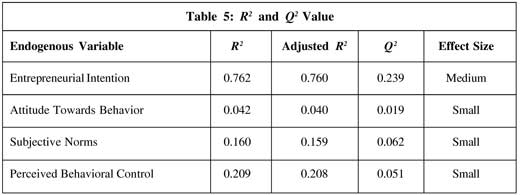
Assessing Q2 Values
Stone-Geisser Q2 value (Geisser, 1974; and Stone, 1974) was calculated through Smart PLS 3 to cross-validate the model and assess the predictive relevance through blindfolding technique (Hair et al., 2013) with an omission distance of 7. The results yielded cross-validated redundancy Q2 values of all the endogenous variables in the model. It was observed that EI has a Q2 value of 0.239 indicating medium effect. ATB (0.019), SN (0.062) and PBC (0.051) indicated small effect size. This indicates acceptable predictive power of the study model because all the Q2 values are greater than 0.
Assessing f2 Values (Whether a Significant Effect Is a Meaningful Effect)
f2 is known as effect size (Cohen, 1988). There are guidelines provided to assess effect size. Values of 0.02, 0.15, and 0.35, respectively, represent small, medium, and large effects of an exogenous latent variable on an endogenous latent variable. Effect size value less than 0.02 indicates that there is no effect of an exogenous variable on the respective endogenous variable. Effect size also indicates the change in R2 value when a particular exogenous variable is omitted from the model.
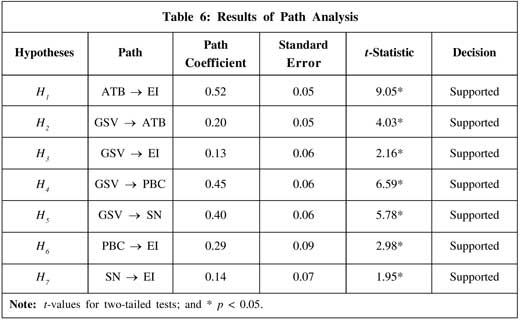
The analysis of effect size indicated that ATB-EI, GSV-PBC, GSV-SN and PBC-EI are meaningful. GSV-ATB, GSV-EI and SN-EI though have significant paths but the effect is not significant (Table 6).
PLS-SEM Output for the Direct Relationship Between Constructs
To evaluate model paths, the method of bootstrapping as suggested by Ringle et al. (2012) was used. The main purpose of bootstrapping is to calculate the standard error of coefficient estimates in order to examine the coefficient's statistical significance (Vinzi and Russolillo, 2010).
Mediation Analysis
This was carried out to examine the causal relationship between an independent variable with a dependent variable by introducing a third explanatory mediator variable (Hair et al., 2017). Towards this end, PLS-SEM bootstrapping approach was deployed for analysis as bootstrapping makes no assumption about sampling distribution of the statistics and can be applied to small sample sizes (Hair et al., 2017). The mediation analysis adopted the approach where the first step is to assess the direct effect of the independent variable on the dependent variable that should be significant without inclusion of the mediator (Zhao et al., 2010). In the step, the mediator is introduced and the effect of indirect path is assessed. All the paths assessed should be individually significant. The indirect paths can be assessed by deploying the PLS-SEM bootstrapping procedure. A significant indirect effect indicates that the mediator absorbs some of the direct path.
Table 7 reveals that ATB and SN are partially mediating the GSV-EI relationship, but PBC is not mediating the GSV-EI relationship.

Conclusion
The study was designed to delve into the role played by social valuation as entrepreneurial activity is enmeshed in social networks and works its way through it. Overall, the study has provided empirical evidence to support the TPB with sample of Indian business students. The study also explored the mediating role of TPB constructs and has come up with some specific findings that provide insights into the development of entrepreneurial intentions.
The findings of the present study confirm the model and establish all the hypothesized model paths. The direct GSV → EI relation is weak (b = 0.13, p < 0.5) but significant. It can be concluded that the social valuation of entrepreneurial career is influenced through attitude, subjective norm and perception of behavioral control—the central TPB constructs. Social valuation is influencing perception of behavioral control (b = 0.45, p < 0.5), but strong perception of behavioral control may not get translated into strong entrepreneurial intention as the influence of PBC → EI (b = 0.29, p < 0.5) is weaker. Similarly social valuation is influencing subjective norms (b = 0.40, p < 0.5), but the influence of SN → EI (b = 0.14, p < 0.5) is not as strong. The positive perception of entrepreneurial career is evident as influence of ATB → EI (b = 0.52, p < 0.5) is strong and influence of GSV &rarrl ATB (b = 0.20, p < 0.5) is weak. Therefore it has emerged that attitude towards behavior is the most important factor influencing entrepreneurial intentions and it is weakly influenced by social valuation. Social valuation is influencing perception of behavioral control and subjective norms but not attitude towards behavior.
The results of mediation analysis yielded partial mediation for GSV-ATB-EI and GSV - SN - EI, whereas no mediation was observed for GSV-PBC-EI relationship for the sample under consideration. ATB and SN are partially translating the direct GSV-EI relationship, whereas PBC is not acting as a translator. The findings of the study are corroborated by GEM Report (2016).
Implications
For Policy Makers: The findings of the study provide insights to the policy makers to enhance the entrepreneurial behaviors amongst students. They need to make the environment conducive for such activities. Since social valuation is an enabler for entrepreneurship, the valuation for entrepreneurship should be made positive through conducive policies from government. The government has indeed taken cognizance of this and come out with entrepreneurship development programs such as Startup India, Stand Up India, Skill India and Make in India aimed at supporting entrepreneurship development and creating a favorable entrepreneurial ecosystem. Such initiatives need to percolate to the institute, college/university level and students on the verge of career choice decision should be motivated to consider entrepreneurship as a viable career choice.
For University Decision Makers: The research can help university decision makers to design a holistic strategy to foster entrepreneurship to spark interest in the students. Specifically management institutes can provide awareness to the students, build capacity and have mentoring boards to help students with viable business ideas.
Limitations: The present study is not without limitations. The sample comprises final year management students only. Therefore, the study explores only a specific sample. Generalization of the results of the study is a limitation. The study has not delved into actual entrepreneurial behaviors. To study if intention is getting converted to behavior would require a study with longitudinal design. The inclusion of additional variables that have an impact on intention would constitute a robust design. The data was collected from Mumbai only. Regional variations in entrepreneurial intentions have been reported in literature.
Scope for Future Studies: Future studies can conduct closer valuation of entrepreneurial behaviors. This would help shed light on the role played by family members and others in the closer network of the individual. This is important in the Indian context where family ties and emotional bonding between family members are strong. According to Damodaran (2013), some regions in India have achieved dramatically high levels of entrepreneurship, while other regions have not. Such differences could be due to differences in government policies (Asher, 2014) or due to the presence or absence of traditional entrepreneurial communities such as Marwaris, Gujaratis, Parsis, etc. (Medhora, 1965). According to GEM Report 2015 and 2016, the state of Gujarat and Chhattisgarh ranked high in entrepreneurship as the preferred career choice in comparison to other regions of India. All these factors can be taken into consideration for further research.
Based on the results of the study, it can be concluded that the role of social valuation is indeed very important. The outcome of this study can help better understand the cognitive process of entrepreneurial intention configuration. Hence, the study is a unique step ahead in entrepreneurial intentions domain as the insight from the study is a step forward in demystifying the phenomenon.
References
- Ajzen I (1991), "The Theory of Planned Behavior", Organization Behavior and Human Decision Processes, Vol. 50, No. 2, pp. 179-211.
- Ajzen I (2002), "Perceived Behavioral Control, Self-Efficacy, Locus of Control, and the Theory of Planned Behavior", Journal of Applied Social Psychology, Vol. 32, No. 1, pp. 1-20.
- Asher M (2014), "Growth Drivers and Mr Modi's Economic Reasoning", Pragati: The Indian National Interest Review. Retrieved from ://pragati.nationalinterest.in/2014/02/growth-drivers-and-mr-modis-economicreasoning/
- Bandura A (1986), "The Explanatory and Predictive Scope of Self-Efficacy Theory", Journal of Clinical and Social Psychology, Vol. 4, Special Issue: Self-Efficacy Theory in Contemporary Psychology, pp. 359-373.
- Bansal H S and Taylor S F (2002), "Investigating Interactive Effects in the Theory of Planned Behavior in a Service-Provider Switching Context", Psychology and Marketing, Vol. 19, No. 5, pp. 407-425.
- Bird B (1988), "Implementing Entrepreneurial Ideas: The Case for Intentions", Academy of Management Review, Vol. 13, No. 3, pp. 442-454.
- Blue C L, Marrero D G and Black D R (2008), "Physical Activity Belief Scales for Diabetes Risk: Development and Psychometric Testing", Health Education & Behavior, Vol. 35, No. 1, pp. 316-331.
- Campbell D T and Fiske D W (1959), "Convergent and Discriminant Validation by the Multitrait-Multimethod Matrix", Psychological Bulletin, Vol. 56, pp. 81-105.
- Cohen J (1988), Statistical Power Analysis for the Behavioral Sciences, 2nd Edition, Lawrence Erlbaum Associates, Mahwah.
- Costello A B and Osborne J W (2005), "Exploratory Factor Analysis: Four Recommendations for Getting the Most from Your Analysis", Practical Assessment, Research, and Evaluation, Vol. 10, No. 7, pp. 1-9.
- Damodaran H (2013), "Whither Bengali Enterprise?", The Hindu. Retrieved from http://www.thehindubusinessline.com/opinion/columns/harishdamodaran/whither-bengali-enterprise/article4686526.ece
- Davidsson P and Honig B (2003), "The Role of Social and Human Capital Among Nascent Entrepreneurs", Journal of Business Venturing, Vol. 18, No. 3, pp. 301-331.
- Farooq M S, Jaafar N, Ayupp K et al. (2016), "Impact of Entrepreneurial Skills and Family Occupation on Entrepreneurial Intentions", Science International, Lahore, Vol. 28, No. 3, pp. 3145-3148.
- Geisser S (1974), "A Predictive Approach to the Random Effects Model", Biometrika, Vol. 61, No. 1, pp. 101-107.
- GEM (Global Entrepreneurship Monitor) Report (2016). Retrieved from https://www.gemconsortium.org/report/49812 on April 30, 2018.
- GEM (Global Entrepreneurship Monitor) Report (2017). Retrieved from https://www.gemconsortium.org/report/49812 on March 2, 2018.
- Hair J F, Black W C, Babin B J and Anderson R E (2010), Multivariate Data Analysis, 7th Edition, Prentice Hall, Upper Saddle River, New Jersey.
- Hair J F, Ringle C M and Sarstedt M (2013), "Partial Least Squares Structural Equation Modeling: Rigorous Applications, Better Results and Higher Acceptance", Long Range Planning, Vol. 46, Nos. 1-2, pp. 1-12.
- Hair J F, Hult G T M, Ringle C M and Sarstedt M (2014a), A Primer on Partial Least Squares Structural Equation Modeling, Sage, Thousand Oaks, CA.
- Hair Jr J F, Sarstedt M, Hopkins L and Kuppelwieser V G (2014b), "Partial Least Squares Structural Equation Modeling (PLS-SEM): An Emerging Tool in Business Research", European Business Review, Vol. 26, No. 2, pp. 106-121.
- Hair J F, Hollingsworth C L, Randolph A B and Chong A Y L (2017), "An Updated and Expanded Assessment of PLS-SEM in Information Systems Research", Industrial Management & Data Systems, Vol. 117, No. 3, pp. 442-458.
- Henseler J, Ringle C M and Sinkovics R R (2009), "The Use of Partial Last Squares Path Modelling in International Marketing", in Rudolf R Sinkovics and Pervez N Ghauri (Eds.), New Challenges to International Marketing (Advances in International Marketing), Vol. 20, pp. 277-319, Emerald Group Publishing Limited, Bingley.
- Henseler J, Ringle C M and Sarstedt M (2015), "A New Criterion for Assessing Discriminant Validity in Variance-Based Structural Equation Modeling", Journal of the Academy of Marketing Science, Vol. 43, No. 1, pp. 115-135.
- Heuer Annamária and Kolvereid Lars (2014), "Education in Entrepreneurship and the Theory of Planned Behaviour", European Journal of Training and Development, Vol. 38, No. 6, pp. 506-523.
- Ketchen D J (2013), "A Primer on Partial Least Squares Structural Equation Modeling", Book Review, Long Range Planning, Vol. 46, No. 2, pp. 184-185.
- Kline R B (2005), Principles and Practice of Structural Equation Modeling, 2nd Edition, The Guilford Press, New York.
- Kolvereid L (1996), "Organizational Employment Versus Self-Employment: Reasons for Career Choice Intentions", Entrepreneurship Theory and Practice, Vol. 20, No. 3, pp. 23-31.
- Krueger N F, Reilly M D and Carsrud A L (2000), "Competing Models of Entrepreneurial Intentions", Journal of Business Venturing, Vol. 15, No. 5, pp. 411-432.
- Lent R W, Brown S D and Hackett G (1994), "Toward a Unifying Social Cognitive Theory of Career and Academic Interest, Choice and Performance", Journal of Vocational Behaviour, Vol. 45, No. 1, p. 79.
- Lin N (2003), Social Capital, a Theory of Social Structure and Action, Cambridge University Press, Cambridge.
- Liñán F and Chen Y W (2009), "Development and Cross-Cultural Application of a Specific Instrument to Measure Entrepreneurial Intentions", Entrepreneurship Theory and Practice, Vol. 33, No. 3, pp. 593-617.
- Liñán F and Fayolle A (2015), "A Systematic Literature Review on Entrepreneurial Intentions: Citation, Thematic Analyses, and Research Agenda", International Entrepreneurship and Management Journal, Vol. 11, No. 4, pp. 907-933.
- Liñán F and Santos F J (2007), "Does Social Capital Affect Entrepreneurial Intentions?", International Advances in Economic Research, Vol. 13, No. 4, pp. 443-453.
- Liñán F, Urbano D and Guerrero M (2011), "Regional Variations in Entrepreneurial Cognitions: Start-up Intentions of University Students in Spain", Entrepreneurship and Regional Development, Vol. 23, Nos. 3-4, pp. 187-215.
- Liñán F, Nabi G and Krueger N (2013), "British and Spanish Entrepreneurial Intentions: A Comparative Study", Revista de Economia Mundial, Vol. 33, pp. 73-103.
- Lowry P B and Gaskin J E (2014), "Partial Least Squares (PLS) Structural Equation Modeling (SEM) for Building and Testing Behavioral Causal Theory: When to Choose it and How to Use it", IEEE Transactions on Professional Communication, Vol. 57, No. 2, pp. 123-146.
- Luthje C and Franke N (2003), "The 'Making' of an Entrepreneur: Testing a Model of Entrepreneurial Intent Among Engineering Students at MIT", R&D Management, Vol. 33, No. 2, pp. 135-148.
- Maichum K, Parichatnon S and Peng K C (2016), "Application of the Extended Theory of Planned Behavior Model to Investigate Purchase Intention of Green Products Among Thai Consumers", Sustainability, Vol. 8, No. 10, p. 1077.
- McKeever E, Jack S and Anderson A (2014), "Embedded Entrepreneurship in the Creative Re-Construction of Place", Journal of Business Venturing [Online], Vol. 30, No. 1, pp. 50-65.
- Medhora P B (1965), "Entrepreneurship in India", Political Science Quarterly, Vol. 80, No. 4, pp. 558-580.
- Mitchell R K, Busenitz L, Lant T et al. (2002), "Toward a Theory of Entrepreneurial Cognition: Rethinking the People Side of Entrepreneurship Research", Entrepreneurship Theory and Practice, Vol. 28, No. 6, pp. 505-518.
- Nahapiet J and Ghoshal S (1998), "Social Capital, Intellectual Capital, and the Organizational Advantage", Academy of Management Review, Vol. 23, No. 2, p. 242.
- Piperopoulos P and Piperopoulos G (2010), "Is Greece Finally on the Right Path Toward Entrepreneurship, Innovation, and Business Clusters?", International Journal of Public Administration, Vol. 33, No. 1, pp. 55-59.
- Ringle C M, Wende S and Will A (2005), Smart PLS 2.0 M3, University of Hamburg, Hamburg, available at www.smartpls.de
- Ringle C M, Sarstedt M and Straub D W (2012), "A Critical Look at the Use of PLS-SEM in MIS Quarterly", MIS Quarterly, Vol. 36, No. 1, pp. iii-xiv.
- Ringle C M, Sarstedt M and Schlittgen R (2014), "Genetic Algorithm Segmentation in Partial Least Squares Structural Equation Modeling", OR Spectrum, Vol. 36, No. 1, pp. 251-276.
- Sarstedt M (2008), "A Review of Recent Approaches for Capturing Heterogeneity in Partial Least Squares Path Modelling", Journal of Modelling in Management, Vol. 3, No. 2, pp. 140-161.
- Sekaran U (2003), Research Method for Business: A Skill Building Approach, 4th Edition, John Wiley & Sons Inc., New York.
- Sekaran U and Bougie R (2010), Research Methods for Business: A Skill Building Approach, 5th Edition, John Wiley and Sons Ltd.
- Souitaris V, Zerbinati S and Al-Laham A (2007), "Do Entrepreneurship Programmes Raise Entrepreneurial Intention of Science and Engineering Students? The Effect of Learning, Inspiration and Resources", Journal of Business Venturing, Vol. 22, No. 4, pp. 566-591.
- Stone M (1974), "Cross-Validatory Choice and Assessment of Statistical Predictions", Journal of the Royal Statistical Society, Vol. 36, No. 2, pp. 111-147.
- Srivastava Sumita and Misra Rupali (2017), "Exploring Antecedents of Entrepreneurial Intentions of Young Women in India: A Multi-Method Analysis", Journal of Entrepreneurship in Emerging Economies, Vol. 9, No. 2, pp. 181-206.
- Thompson E R (2009), "Individual Entrepreneurial Intent: Construct Clarification and Development of an Internationally Reliable Metric", Entrepreneurship Theory & Practice, Vol. 33, No. 3, pp. 669-694.
- VanGelderen M, Brand M, Van Praag M et al. (2008), "Explaining Entrepreneurial Intentions by Means of the Theory of Planned Behaviour", Career Development International, Vol. 13, No. 6, pp. 538-559.
- Vinzi V Esposito and Russolillo G (2010), "Partial Least Squares Path Modeling and Regression", in E Wegman, Y Said and D Scott (Eds.), Wiley Interdisciplinary Reviews: Computational Statistics, Wiley, New York.
- World Employment and Social Outlook – Trends 2017, available at https://www.ilo.org/wcmsp5/groups/public/---dgreports/---dcomm/---publ/documents/publication/wcms_ 541211.pdf. Accessed on April 15, 2018.
- Zhao X, Lynch J G Jr, and Chen Q (2010), "Reconsidering Baron and Kenny: Myths and Truths About Mediation Analysis", Journal of Consumer Research, Vol. 37, No. 2, pp. 197-206.
- Zikmund W G, Babin B J, Carr J C and Griffin M (2010), Business Research Methods, 8th Edition, Cengage Learning, Mason, HO.
